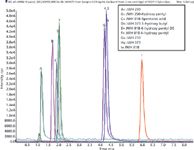Extraction of Synthetic Cannabinoids Parents and Metabolites (JWH Series) from Urine, Plasma, and Whole Blood Using Supported Liquid Extraction (ISOLUTE? SLE+) in Cartridge and 96-Well Format Prior to LC–MS-MS
Biotage, LLC
Synthetic Cannabinoids, or SPICE, are synthetic compounds that bind to the cannabinoid receptors in mammals, and hence trigger similar euphoric symptoms to tetrahydrocannabinoid (THC), the active component in marijuana. A robust and fast sample extraction method from various biological matrices has been developed to aid in accurate detection and quantitation of these compounds and their metabolites. Here we demonstrate the use of supported liquid extraction (SLE) for extraction and quantitation of the parent and metabolites from the JWH series.
Experimental Conditions
Urine Extraction:
Add 5000 units/mL of β-glucuronidase to the urine and dilute 1:1 with 100 mM ammonium acetate (pH 5). Spike the matrix solution with internal standard. Incubate sample as per instructions with enzyme (optional).
Load urine sample (hydrolyzed or unhydrolyzed) onto a cartridge or 96-well plate. Apply a short pulse of vacuum or positive pressure and allow sample to stand for 5 min.
Urine (cartridge): Apply ethyl acetate (2 × 3 mL to 1 mL ISOLUTE SLE+ cartridge) or (3 × 500 μL onto a 400 μL 96-well plate). Allow the sample to elute under gravity. Apply a short pulse of vacuum or positive pressure to collect the eluent.
Plasma/Whole Blood Extraction:
Dilute 1 mL plasma or 1 mL whole blood 1:1 (v/v) with HPLC grade water.
Load pre-treated sample onto a 2 mL ISOLUTE SLE+ cartridge. Apply a short pulse of vacuum or positive pressure and allow sample to stand for 5 min.
Apply Hexane (2 x 4 mL) to the cartridge. Allow sample to elute under gravity. Apply short pulse of vacuum or positive pressure to collect the eluent.
Post Extraction (All Samples):
Evaporate extracted samples to dryness and reconstitute sample in mobile phase.

Figure 1: Typical extracted ion chromatogram for elution of urine extracted synthetic cannabinoids and metabolites spiked at a concentration of 10 ng/mL. Samples were eluted from a standard fused core C18 column with an isocratic mobile phase of 0.1% formic acid: Methanol with 0.1% formic acid (20:80) for 8 min and detected using a triple quadrupole mass spectrometer.
Results
A typical extracted ion chromatogram (XIC) for the target suite of synthetic cannabinoid parent and metabolites is shown in Figure 1. Typical recoveries obtained for the extraction of synthetic cannabinoids parent and metabolites using ISOLUTE® SLE+ technology ranged from 70–98% (Figure 2). Calibration curves were generated from the extracted urine samples and used to quantitate known values for in-house quality control samples to within ±10% accuracies. (Data not shown here.)
Figure 2: Averaged % recoveries for urine extracted synthetic cannabinoids and their metabolites.
References
(1) G. Dowling, L. Williams, R. Jones, and L, Regan, "Evaluation of Supported Liquid Extraction (SLE) for the Determination of Cannabis and Synthetic Cannabinoid Compounds in Blood", poster presented at Society of Forensic Toxicology general meeting, 2011.
Biotage, LLC
10430 Harris Oaks Blvd., Suite C, Charlotte, NC 28269
Email: product_info@biotage.com
Website: www.biotage.com

SEC-MALS of Antibody Therapeutics—A Robust Method for In-Depth Sample Characterization
June 1st 2022Monoclonal antibodies (mAbs) are effective therapeutics for cancers, auto-immune diseases, viral infections, and other diseases. Recent developments in antibody therapeutics aim to add more specific binding regions (bi- and multi-specificity) to increase their effectiveness and/or to downsize the molecule to the specific binding regions (for example, scFv or Fab fragment) to achieve better penetration of the tissue. As the molecule gets more complex, the possible high and low molecular weight (H/LMW) impurities become more complex, too. In order to accurately analyze the various species, more advanced detection than ultraviolet (UV) is required to characterize a mAb sample.










